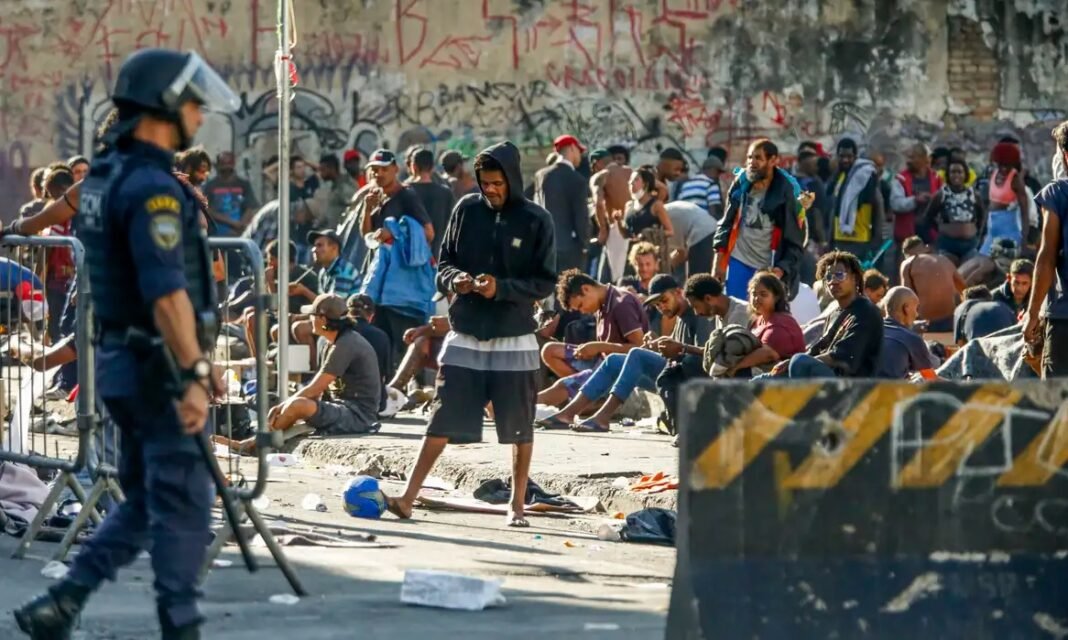The dispersion of drug users from Rua dos Protestantes, in Santa Ifigênia, has brought to Praça Marechal Deodoro a dynamic already familiar in Cracolândia: the setting up of makeshift stalls for product sales. Located in the Santa Cecília neighborhood, also in downtown São Paulo, the square has seen a growing presence of crack users. Following the exodus from Rua dos Protestantes, the flow of addicts — as the concentration of drug users is known — has continued into this new area, according to residents.
This Content Is Only For Subscribers
To unlock this content, subscribe to INTERLIRA Reports.
Sales Stalls
The appearance of informal stalls selling products has long been a characteristic of Cracolândia’s main gathering points, dating back to the users’ occupation of the area near Júlio Prestes Station, where the flow continued for two decades. As the groups moved, these stalls began appearing in other locations such as Rua dos Gusmões, Rua Helvétia, and Rua Vitória. However, their emergence in Praça Marechal Deodoro — near the Minhocão and close to the upscale Higienópolis neighborhood — is a new development and suggests a growing organization of the flow in this space.
50 people
The area is regularly occupied by users who gather in the square and spill onto nearby sidewalks, with the group reaching over 50 people at times. While this is currently one of the largest concentrations of users in this downtown region, the figure remains far lower than past numbers at other Cracolândia points. For example, drone surveys conducted by São Paulo’s municipal government last year recorded an average of 280 individuals on Rua dos Protestantes. In May 2023, around 400 users were present at one time on Rua Guaianases.
New PM Base
The Military Police recently installed a base in Praça Marechal Deodoro to address the growing situation. The trailer-like unit was placed on Wednesday (28/05), and by Monday (02/05), a visible reduction in the number of crack users and homeless individuals in the area had already been reported. In a public statement, the Department of Public Security said the basis is meant to enhance police presence and prevent criminal activity. Since August 2024, seven permanent community policing bases have been inaugurated out of 11 planned, with the remaining bases expected to be delivered by July.
New Tactics
In addition, another tactic used by the Military Police and the Metropolitan Civil Guard to disperse groups of drug users — and thus prevent new crack dens from forming in downtown São Paulo — is the activation of sirens. When officers detect a gathering, they approach the group and sound the sirens of their police vehicles. The users interpret this as a signal to disperse and begin wandering, often aimlessly, through the area, many draped only in blankets. This practice has prompted complaints from downtown residents, who report being unable to sleep due to the frequent sirens, especially during the early morning hours. The dispersals by police and guards appear to lack a definitive objective, as the drug users merely move from one location to another.
Analysis:
The migration of the so-called “flow” of drug users from Rua dos Protestantes to Praça Marechal Deodoro represents yet another stage in the cycle of unresolved dispersal that has characterized the management of Cracolândia in recent decades. The installation of improvised stalls to sell products, a traditional element of the old gatherings near Estação Júlio Prestes, reveals the growing informal structuring of the new meeting point in Santa Cecília, in an area bordering upscale neighborhoods such as Higienópolis.
The regular presence of around 50 people — although lower than previous peaks in other areas — points to the consolidation of a new hub of urban vulnerability. The response of the Military Police, with the installation of a fixed base and the intensification of overt actions such as the use of sirens, signals a reactive effort focused on immediate dispersal but lacks clear guidelines to effectively demobilize the dynamics of drug trafficking, urban degradation, and the permanence of users in a situation of homelessness.




